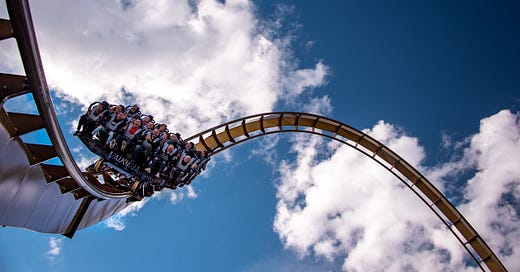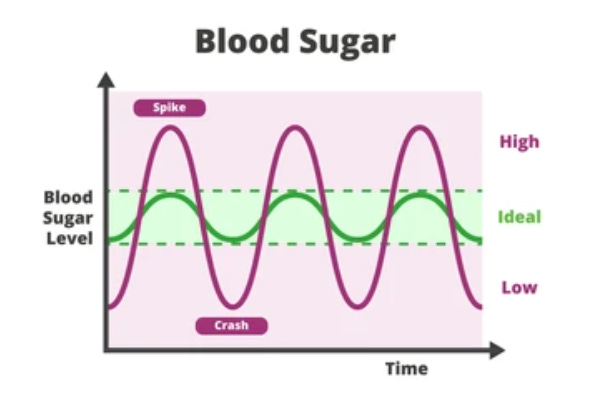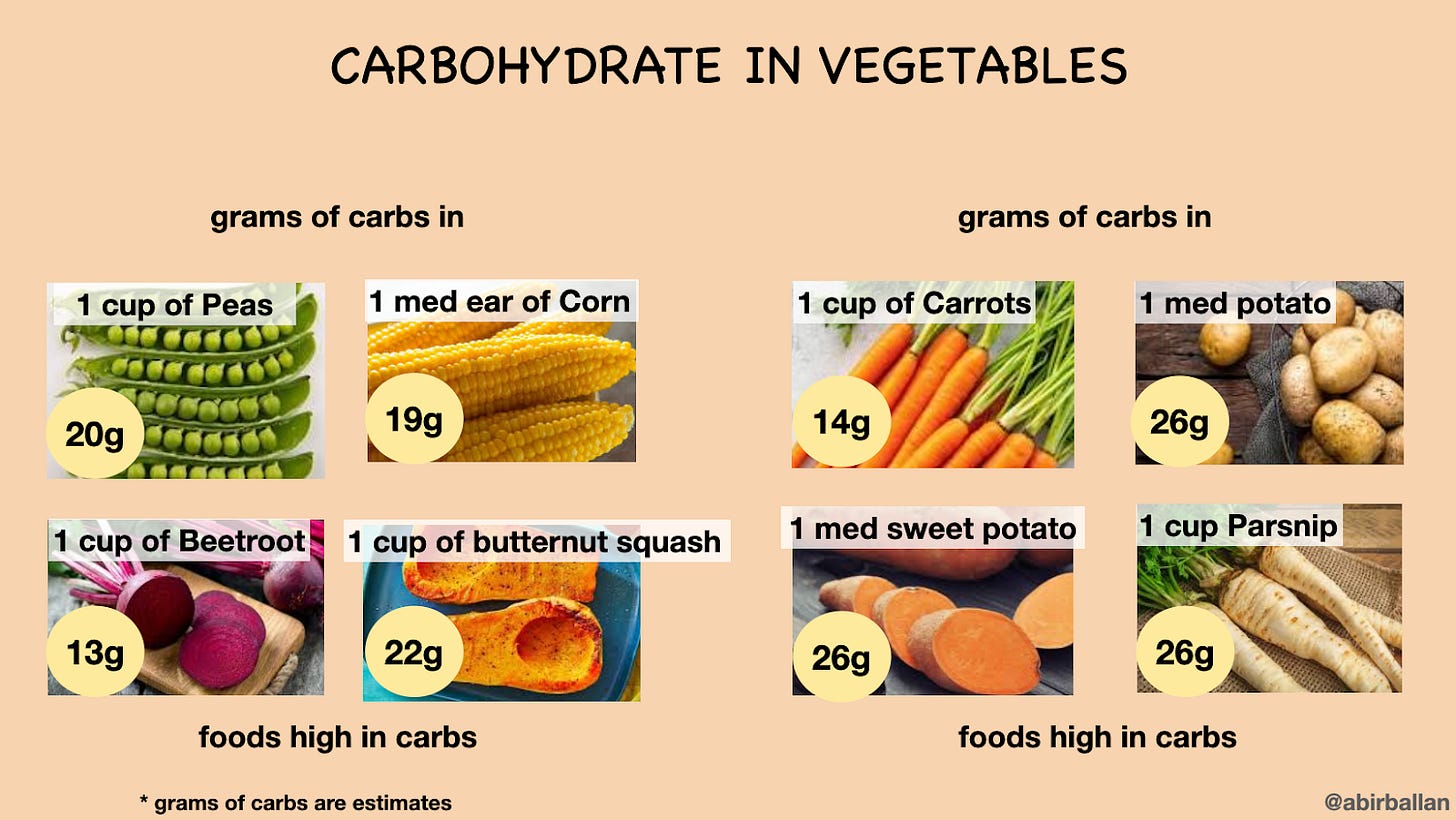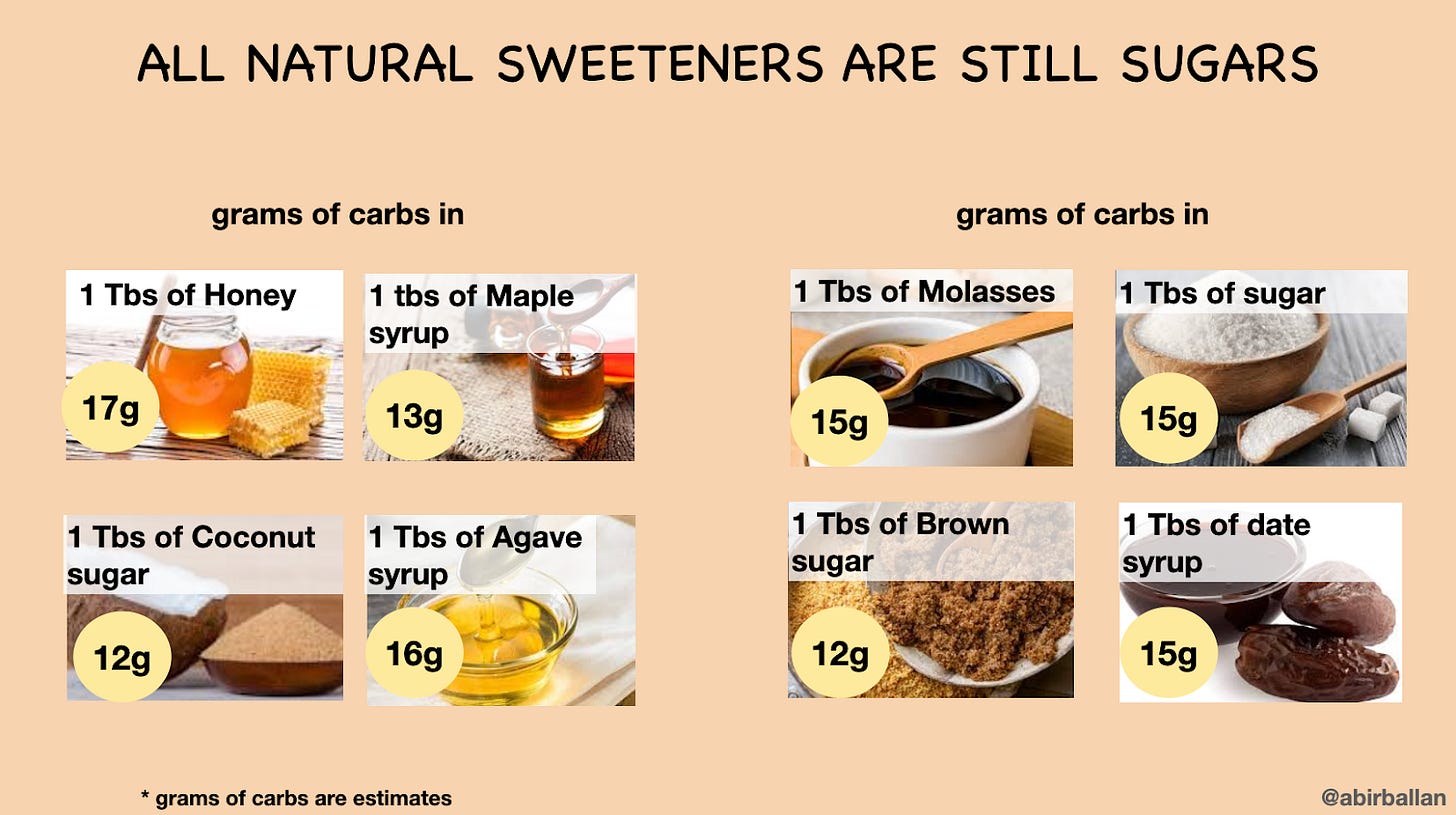WHAT ARE CARBOHYDRATES?
Carbohydrates are macronutrients made up of sugar molecules. Sugars serve as a source of energy for the body.
There are simple carbohydrates…. (absorbed into the bloodstream quickly)
And there are complex carbohydrates… (absorbed into the bloodstream slower than simple carbs)
WHAT IS THE SUGAR ROLLER COASTER?
Every time you eat carbs (bread, pasta, rice, potatoes, starchy vegetables, legumes, sweets, sugars, syrups, honey and even fruits), your blood sugar spikes leading to a spike in insulin (‘the fat storing hormone’) to remove the sugar from the blood and into the cells (where if not used, it gets stored as fat). Following the insulin spike, blood sugar drops leading to a crash, prompting your body to secrete cortisol (‘the stress hormone’) which releases stored glucose into the blood. Meanwhile, the sugar crash also leads to a feeling of sluggishness and hunger– a cue to eat again as the body tries to regulate blood sugar (to keep it in the green zone- see above). As you eat more carbs, another spike is caused, taking you on a blood sugar roller coaster ride. This process is very harmful to the body leading to inflammation, glycation (aging process) and chronic diseases, such as diabetes, hypertension, heart disease, obesity, dementia and cancer. In order to prevent and reverse these chronic diseases, it’s essential to jump off the roller coaster ride and regulate your blood sugar level.
WHICH FOODS CONTAIN CARBS?
Notice the amount of carbs vs protein in animal food vs legumes.
Which foods give you the most protein and the least carbs?
These foods will get you off the sugar roller coaster.
Legumes are nutritious. That’s why they earned the nickname of ‘Good’ Carbs. They are, however, made up of sugar molecules and they increase blood sugar and insulin levels. If you want to regulate your blood sugar to reverse a chronic condition or lose weight, it’s important to cut down on legumes too.
Seeds and nuts contain a little bit of carbs but they also contain proteins and good fats which help in regulating blood sugar levels.
Notice the amount of carbs in grains and sweets:
That’s right. They are sugar-spiking foods.
Non-starchy vegetables are very low in carbs. Indulge in them to your heart’s desire. Add some seasoning, some olive oil, maybe garlic, et voilà, a scrumptiously delicious side dish.
⚠️ On the other hand, watch out for starchy vegetables (see below).
Most fruits are very high in sugar (the body deals with fructose in the same way as other sugars). Again, if you want to regulate your blood sugar level to reverse a chronic condition or lose weight, it’s important to cut down on fruits too.
Fruit juices are sugar shots as all the fiber, in the real fruit that normally slows down absorption and helps reduce the sugar spike, is removed.
It’s always better to opt for the whole fruit rather than the fruit juice.
Eat your fruit right after a meal to prevent a sugar spike (proteins, veggies and fats act like a cushion and slow down sugar absorption into the bloodstream). Alternatively you can combine fruits with nuts, seeds, nuts butter or dairy (e.g., grapes and cheese).
IS ANY SWEETENER BETTER?
The short answer is: NO. Although some natural sweeteners may contain more minerals, they all spike blood sugar levels equally. Consider them all DESERT and maybe keep them for celebrations or a once/week treat.
All artificial sweeteners (sugar names ending with -ame like aspartame or -ol like Sorbitol, Xylitol…) are highly processed and may contain carcinogenic substances. You may want to avoid those completely, if this is important to you.
WHAT ABOUT STEVIA?
Stevia is a natural sweetener that contains 1.5 g of carbs in 1 Tbsp of stevia. Although it has almost zero calories, it will sustain the sugar addiction as your brain will secrete dopamine when it detects the sweet taste. If the sugar addiction is sustained, you will continue to crave sweets and carbs which come with a lot of sugar. (see below on sugar addiction)
ARE HOMEMADE SWEETS BETTER?
In a way, yes: they don’t contain toxins if you use natural whole ingredients. In a way, no: they will spike your blood sugar levels because they mostly contain starches and sweeteners. So eat them sparingly and when you do, eat them right after a nourishing meal to reduce the sugar spike.
WHAT ARE HIDDEN SUGARS IN FOOD?
Food manufacturers use different words for sugar in their ingredients. Here’s a list to help you make a more informed decision:
All natural sweeteners (honey, maple syrup, coconut sugar, molasses, brown sugar)
All artificial sweeteners ending with –ame or –ol
Words ending with -ose like dextrose, maltose, sucrose, fructose, sucralose…
Dextrin and Maltodextrin
Corn, high-fructose corn and carob Syrup
Fruit juice concentrate (fructose)
Caramel
Malt
LOW-CARB OR NO-CARB, THAT IS THE QUESTION?
I know you are wondering now what A LOW-CARB meal looks like …
LOW-CARB MEAL= 1/2 vegetables + ¼ animal protein + ¼ good carb
TIP: Remember to go for a walk after eating carbs to use up the sugar in your blood
And you are probably also wondering what a NO-CARB meal looks like…
NO-CARB meal= 3/4 vegetables + ¼ animal protein
This is the ultimate rejuvenating, healing, strengthening and nourishing meal and it is delicious.
TIP: If you eat nourishing meals (animal protein + veggies + good fats), you prevent snacking urges between meals
WHAT IS THE TAKE-AWAY?
In order to jump off the sugar roller coaster, eat less meals (so no snacking, unless you like snacking on cucumbers and lettuce then munch on…) and eat foods that keep your blood sugar regulated. The key to a successful nutrition plan is to feel satiated (instead of deprived) and to be rewarded with your desired results (lose weight, prevent or reverse chronic conditions, age gracefully, feel better & healthier…)
Eat WHOLE FOOD.
Get your daily requirement of PROTEINS from animal sources (about 1 g of protein per ideal body weight)
Aim for 10-12 servings of rainbow-coloured non-starchy VEGETABLES to get a wide range of phytonutrients, antioxidants, vitamins and minerals (1 serving= ½ cup of vegetables or 1 cup of raw leafy greens)
Have some healthy fats to meet your daily energy requirement without exceeding it (Healthy fats are found in animal meat, dairy products, butter, ghee, coconut oil, olive, sesame and walnut oil, nuts, seeds, peanuts, avocado, coconut, olives, cocoa powder)
Choose between LOW-CARB or NO-CARB meals (depending on your goal). The more you choose NO-CARB, the more you gift yourself strength, healing, nourishment and rejuvenation
Limit FRUITS to 1-3 medium fruits per day (depending on your goal). Eat it right after a meal to prevent a sugar spike
Limit sweets to once per week or less. Eat it right after a meal to prevent a sugar spike.
HYDRATE 1.5-2 L/day (water and non-caffeinated herbal teas)
WHAT IS THE PROMISE?
Sugar increases dopamine levels in the brain (a neurotransmitter associated with pleasure and sustaining addictions). We all love carbs and sweets because they are so rewarding, but they cause inflammation and disease in the body and we all don’t want that.
If you reduce carbs/sweets drastically for one month, you can free yourself from that sugar addiction, and wouldn’t you rather be free?
If you have the courage to stick with it, you will have less sugar and carb cravings. You will feel more satiated and you will find it much easier to follow this diet and even enjoy it. Over time, you will reverse any chronic conditions. You will feel younger, healthier and stronger, and definitely happier.
Just hang in there and feel the difference for yourself.
==> CHECK OUT THE SWITCH CHALLENGE - A HOLISTIC SELF-HELP PROGRAM FOR HEALTH AND WELLBEING
DISCLAIMER: All information provided by Abir Ballan is solely intended for educational purposes and is not a substitute for expert advice, diagnosis, or treatment regarding medical or mental health conditions. Always consult your physician before making any decisions related to your physical or mental health.
ABOUT THE AUTHOR
Abir Ballan is a Health Coach and a certified NLP and Time Line Therapy Practitioner. She has a Masters in Public Health, a Graduate Degree in Special Needs Education and a BA in Psychology. She is a children’s author with 27 published books.
















Great post Abir. I regularly assist ppl to switch to VLCD or low carbs and this is very well put together. Thank you.
Off sugar for nine month now. Still lagging behind with low carb veggies, but I will get to the fully balanced diet one day. Thank You for Your efforts to educate people about their diet.